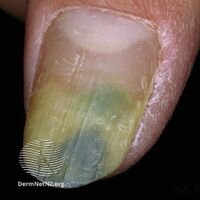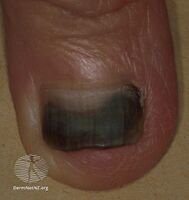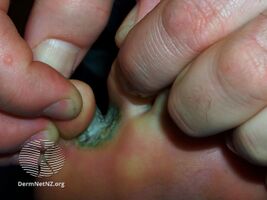Pseudomonas infection
| Pseudomonas infection | |
|---|---|
| Specialty | Dermatology |
Pseudomonas infection refers to a disease caused by one of the species of the genus Pseudomonas.
P. aeruginosa is an opportunistic human pathogen, most commonly affecting immunocompromised patients, such as those with cystic fibrosis[1] or AIDS.[2] Infection can affect many parts of the body, but infections typically target the respiratory tract (e.g. patients with CF or those on mechanical ventilation), causing bacterial pneumonia. In a surveillance study between 1986 and 1989, P. aeruginosa was the third leading cause of all nosocomial infections, and specifically the number one leading cause of hospital-acquired pneumonia and third leading cause of hospital-acquired UTI.[3] Treatment of such infections can be difficult due to multiple antibiotic resistance,[4] and in the United States, there was an increase in MDRPA (Multidrug-resistant Pseudomonas aeruginosa) resistant to ceftazidime, ciprofloxacin, and aminoglycosides, from 0.9% in 1994 to 5.6% in 2002.[5]
P. oryzihabitans can also be a human pathogen, although infections are rare. It can cause peritonitis,[6] endophthalmitis,[7] sepsis and bacteremia. Similar symptoms although also very rare can be seen by infections of P. luteola.[8]
P. plecoglossicida is a fish pathogenic species, causing hemorrhagic ascites in the ayu (Plecoglossus altivelis).[9] P. anguilliseptica is also a fish pathogen.[10]
Due to their hemolytic activity, even non-pathogenic species of Pseudomonas can occasionally become a problem in clinical settings, where they have been known to infect blood transfusions.[11]
-
Pseudomonas infection
-
Pseudomonas infection
-
Pseudomonas infection
References
- ↑ Elkin S, Geddes D (2003). "Pseudomonal infection in cystic fibrosis: the battle continues". Expert Review of Anti-infective Therapy. 1 (4): 609–18. doi:10.1586/14787210.1.4.609. PMID 15482158. S2CID 33383226.
- ↑ Shanson DC (1990). "Septicaemia in patients with AIDS". Trans. R. Soc. Trop. Med. Hyg. 84 Suppl 1: 14–6. doi:10.1016/0035-9203(90)90449-o. PMID 2201108.
- ↑ Schaberd; Culver; Gaynes (1991). "Major trends in the microbial etiology of nosocomial infection" (PDF). The American Journal of Medicine. 91 (3): S72–S75. doi:10.1016/0002-9343(91)90346-Y. hdl:2027.42/29131. PMID 1928195. Archived from the original on 2021-08-29. Retrieved 2021-05-07.
- ↑ McGowan JE (2006). "Resistance in nonfermenting gram-negative bacteria: multidrug resistance to the maximum". Am. J. Med. 119 (6 Suppl 1): S29–36, discussion S62–70. doi:10.1016/j.amjmed.2006.03.014. PMID 16735148.
- ↑ Obritsch; Fish; MacLauren; Jung (2005). "Nosocomial Infections Due to Multidrug-Resistant Pseudomonas aeruginosa: Epidemiology and Treatment Options". Pharmacotherapy. 25 (10): 1353–1364. doi:10.1592/phco.2005.25.10.1353. PMID 16185180. S2CID 36236448.
- ↑ Levitski-Heikkila TV, Ullian ME (2005). "Peritonitis with multiple rare environmental bacteria in a patient receiving long-term peritoneal dialysis". Am. J. Kidney Dis. 46 (6): e119–24. doi:10.1053/j.ajkd.2005.08.021. PMID 16310563.
- ↑ Yu EN, Foster CS (2002). "Chronic postoperative endophthalmitis due to Pseudomonas oryzihabitans". Am. J. Ophthalmol. 134 (4): 613–4. doi:10.1016/S0002-9394(02)01586-6. PMID 12383826.
- ↑ Kodama K, Kimura Nm Komagata K (1985). "Two new species of Pseudomonas: P. oryzihabitans isolated from rice paddy and clinical specimens and P. luteola isolated from clinical specimens". Int J Syst Bacteriol. 35 (Pt 2): 467–74. doi:10.1099/00207713-35-4-467.
- ↑ Nishimori E, Kita-Tsukamoto K, Wakabayashi H (2000). "Pseudomonas plecoglossicida sp. nov., the causative agent of bacterial haemorrhagic ascites of ayu, Plecoglossus altivelis". Int. J. Syst. Evol. Microbiol. 50 (1): 83–9. doi:10.1099/00207713-50-1-83. PMID 10826790.
- ↑ López-Romalde S, Magariños B, Ravelo C, Toranzo AE, Romalde JL (2003). "Existence of two O-serotypes in the fish pathogen Pseudomonas anguilliseptica". Vet. Microbiol. 94 (4): 325–33. doi:10.1016/S0378-1135(03)00124-X. PMID 12829386.
- ↑ Khabbaz RF, Arnow PM, Highsmith AK, et al. (1984). "Pseudomonas fluorescens bacteremia from blood transfusion". Am. J. Med. 76 (1): 62–8. doi:10.1016/0002-9343(84)90751-4. PMID 6419604.
External links
| Classification |
|---|


